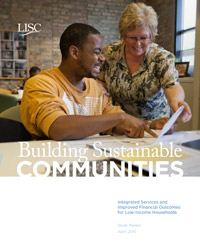LISC study: Employment and financial services help low-income people make progress
LISC researchers recently analyzed outcomes from 40,000 people who visited Financial Opportunity Centers all across the country as a way to improve their economic circumstances. The data show that those who took advantage of bundled services that focused on employment, income supports and financial management skills made significant, lasting progress—with incomes expanding by an encouraging 76 percent. Many thanks to the JPMorgan Chase Foundation for supporting the preparation, publication, and dissemination of this report.
The excerpt below is from:
"Building Sustainable Communities: Integrated Services and Improved Financial Outcomes for Low-Income Households"
Message from the President & CEO
After decades of investing in blighted communities across the country, LISC knows that healthy neighborhoods rest as much on whether residents can earn a decent wage and build financial security as they do on good housing, strong schools and vibrant businesses.
As part of our comprehensive strategy—Building Sustainable Communities—LISC is tackling this pressing need through an expansive network of Financial Opportunity Centers (FOCs) in dozens of communities nationwide. FOCs help clients find and maintain good jobs, stick to realistic budgets, improve their credit and save for the future. And they are located in the same neighborhoods where LISC is investing in housing and health, reducing crime, strengthening schools and re-energizing commercial corridors.
As we developed the FOC program, we embedded a data tracking system to determine whether FOCs help disadvantaged residents stabilize their financial lives in ways they can sustain. Early indicators point to a dramatic shift for FOC clients. LISC researchers evaluated 34 months of outcomes for 40,000 FOC clients, nearly all of whom are in the bottom 20 percent of the nation’s household incomes. When they entered the program, typical FOC clients were making less than $800 per month and nearly two-thirds did not earn enough to cover their monthly expenses.
The research shows a direct relationship between the number and type of services accessed and the FOC clients’ ability to grow their earnings and secure their finances. For instance, those who spent the most time on all three bundled services offered by the FOCs (employment, coaching and public benefits) had the highest job placement rates and the highest job retention rates—a 74 percent placement rate and a 78 percent six-month retention rate. Clients who received both financial counseling and employment services had net income increases that were 89 percent higher than those receiving only financial or income support counseling.
We also learned that:
- 76 percent of clients increased their net income.
- More than half increased their net worth.
- 60 percent either increased their credit score or acquired a credit score.
- 58 percent of those who started with zero or negative net income moved to positive net income.

Those percentages mean real spending power for some of the lowest-income people in the country—dollars that are quickly put back into local economies and catalyze growth.
What sets FOCs apart from traditional workforce development programs is the bundling of services. That’s at the core of the FOC model. The program combines soft skills training, vocational education, and job placement services with one-on-one financial coaching for as long as clients need it, as well as help accessing public benefits for which they are eligible.
We have been actively expanding the FOC program in the past five years and the results to date hold great promise for low-income people and places. LISC is continuing to build this network—with 76 FOCs now up and running—and to incorporate the FOC strategy into broader conversations with local partners about what works in communities.
This report is the second in a series of new LISC research on the impact of comprehensive community development. The first report, Building Sustainable Communities: Initial Research Results, looked at data from 62 communities where LISC has made significant investments and found income and employment gains for residents—regardless of whether they were directly involved in the projects and programs LISC supported. FOCs are part of that effort and an innovative and effective tool for building more stable and comfortable lives for all residents.
Michael Rubinger
